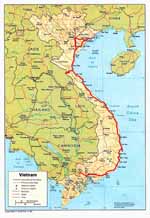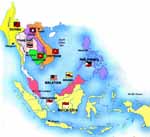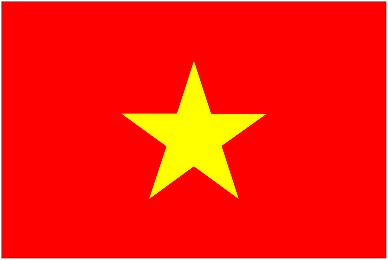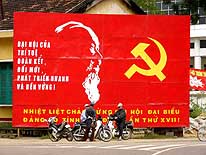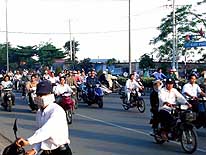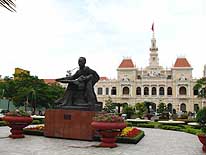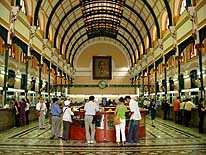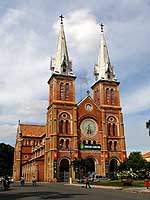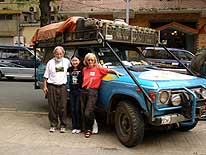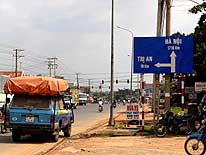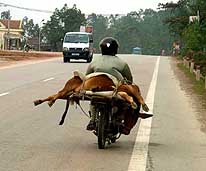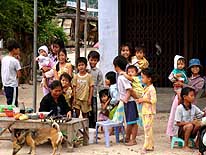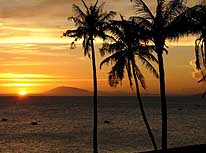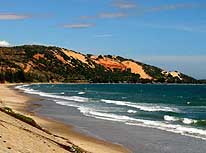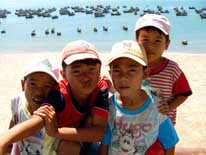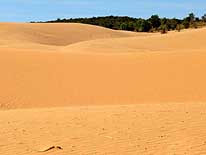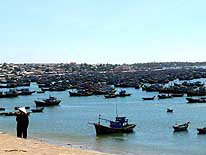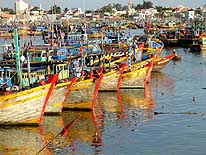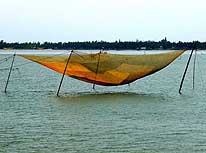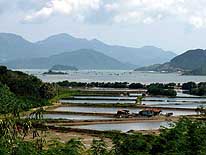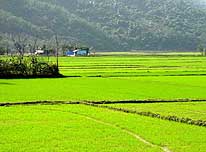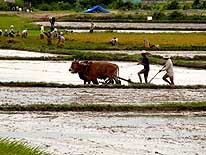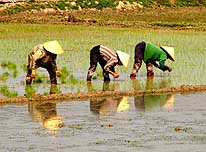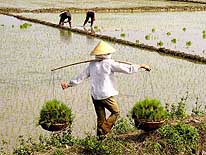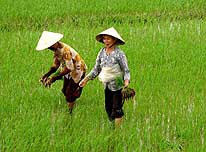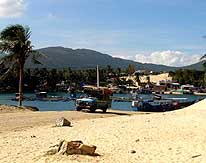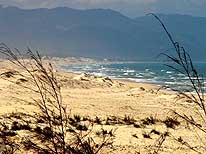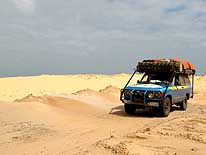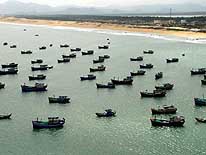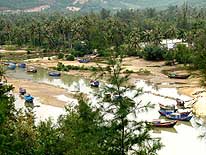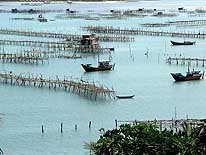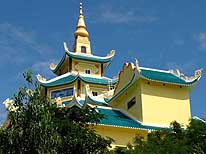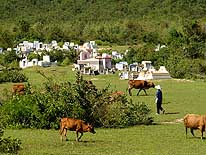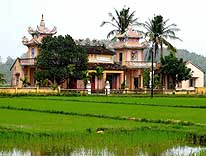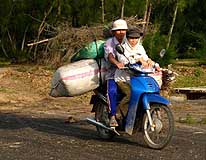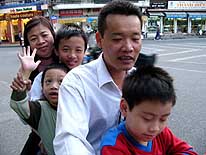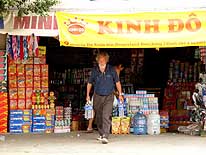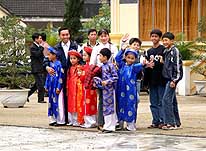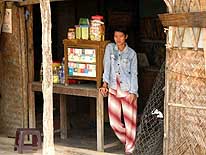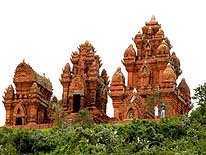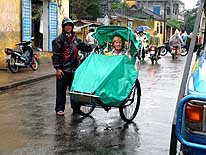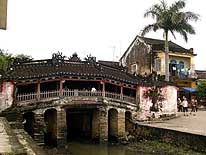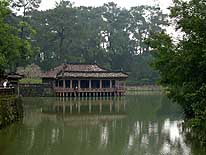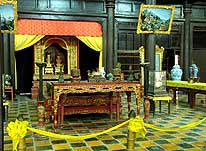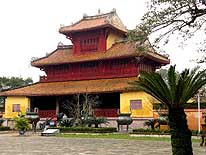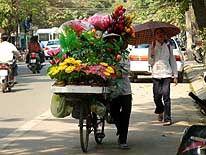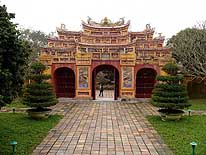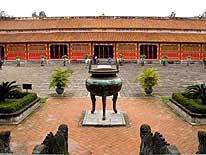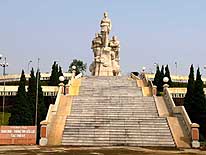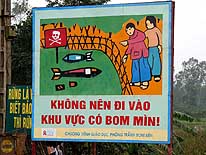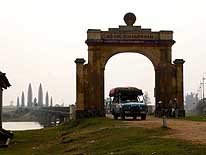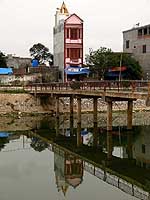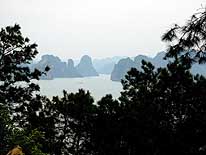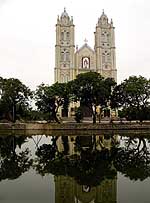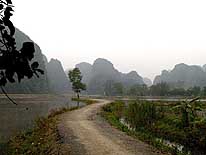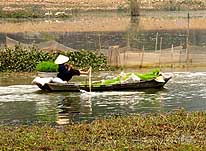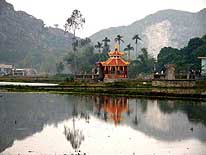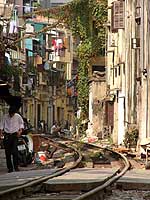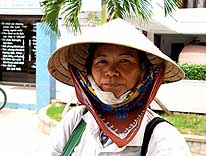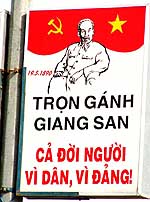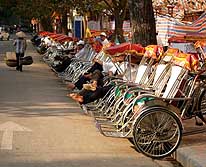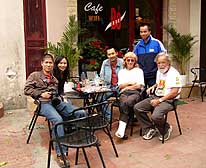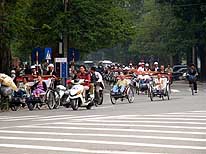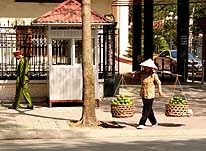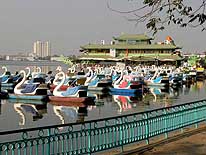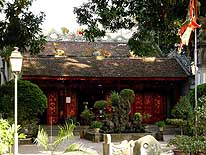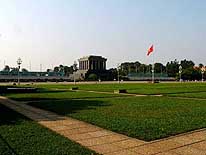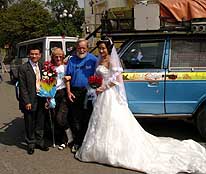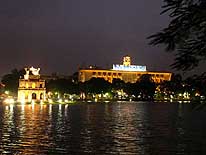![]()
Enjoy some pictures of the worldrecordtour, taken in Vietnam
|
|
click a picture to see details |
|
|
|
|
|
|
|
|
|
Slowly and with a certain respect, we are rolling towards the modern building with the red flag and the yellow star in the middle – to the huge Vietnam border post in Moc Bai. Leaning on Emil on one and on my crutch on the other side, I am hopping painfully in the hot midday sun with my only two days old heavy gypsum cast from Cambodia to the immigration. We are the only people at the booth and our passports are quickly stamped. At customs, two men are sitting behind a long table. The younger one immediately offers me a chair to sit, while the older one takes care of the car’s paper work, leading Emil to a different room. Suddenly, the time I am waiting seems unreasonably long to me, why I slowly start to get a little bit nervous. Am I worrying for no reason? Or is our permit from Hanoi, which we initiated already many weeks ago in Singapore, contrary to all information not ready yet? All kind of troubling reflections cross my head. Then, finally, I see Emil appear together with another officer, walking with him straight to our LandCruiser. And when I realize that the engine and chassis numbers are being checked, I immediately know: We made it! What an enormous relief and what a joy! We just need to fill out another two-sided form and then we are dismissed into our 152nd country with a welcoming handshake of the two helpful customs officers, who showed no interest at all to have a look into our car. Welcome to Vietnam!
|
|||
|
|
|
|
|
|
|
|
Immediately after the border, three things remind us that we just entered a country still ruled by communism: At many buildings, we see the hammer and sickle emblem; at the toll booth of the provincial border bridge, the ticket is cashed in already a hundred yards before by one person, but cancelled by another one only when opening the gate – double control! And shortly afterwards, when we check into a small guesthouse along the road, we have to deposit our passports for police registration. Next morning, we are rolling slowly towards Ho Chi Minh City, the former Saigon. Already in the suburbs, we notice the very narrow and very high buildings in soft pastel colors – from blue, red, green, yellow, orange, purple – everything is present and contributes to the city’s friendly appearance. They are called tunnel or tube houses because of their narrow frontages and deep rooms. They were developed to avoid taxes based on the width of their street frontage. We see them later all over Vietnam, but – for money reasons - mostly only its one-room wide front is brightly painted, the rest shows still its grey cement face.
|
|||
|
|
|
|
|
|
|
|
Coming closer to the city center, navigating through these streets plagued by an incredible motor traffic is getting more and more chaotic and becomes a real gamble. Every possible space is crowded with a stream of steadily moving motorbikes and scooters; they advance like a barrel (apparently there are 4 millions motorbikes in HCMC in comparison to 8 Mio inhabitants), and the slightest distraction, the slightest hesitation, can inevitably provoke an accident. Already now I know that I will make three crosses if we ever manage to leave Vietnam free of accident. Well: Yes, we made it, but only thanks to Emil being such a good driver and his admiring ability to always have full control of what is happening around him. Traffic rules in this country seem to be very basic. People overtake on the right or on the left side or suddenly cross the line without any warning. And nobody ever pays attention what happens behind his back; everybody is concentrating only on the movements ahead.
|
|||
|
|
|
|
| New Years Eve 2005-2006 in Mui Ne: | |||
| Above us, the skies are changing into an intensive orange and yellow ….. | ..… on the water one man fishing baskets are moving with the waves ….. | ..… and in front of us a cow
is grazing peacefully
|
|
We park between the impressive Notre Dame Cathedral and the lovely Post Office built in the French colonial style. It is hard to restrain myself not to get out of the car immediately to explore the surroundings, as I normally do. But unfortunately, I have to realize and also to accept that – due to my broken leg - from now on I will be bound to our car for a couple of weeks at least and will have to rely totally on Emil in many respect. I already know that it will not always be easy for both of us, as we will have to reorganize our lives completely. From now on, it will be only Emil doing all the sightseeing by foot, while I am waiting patiently in the car and will be able to admire many of the beautiful sites only through the pictures of our digital camera. We can also forget to have a drink or a bite to eat if it is not possible to park directly in front of a place. Crossing a street is very risky and a gamble even with two healthy legs, not to mention with a crutch, as nobody ever pays attention to pedestrian crossings anyway.
|
|||
|
|
|
|
|
|
|
|
At least, with a lot of efforts, I manage to walk from our parking lot to the Café nearby the ‘Bao Minh Saigon Insurance’. There, we meet Tam, who works for this insurance company and who unselfishly did her utmost to assist us - even at her days off over the weekend -, that the compulsory third party insurance policy - which we organized from Cambodia - was faxed to the police of the border post in time. Actually, we expect her to be a resolute lady and are very surprised to find a shy student, an admirable young Vietnamese girl with many ideals and a great sense of engagement. She finds her way straight into our hearts. She is really disappointed that we cannot accept her invitation to join her on December 31st to the party at the Horizon International School, because we already made other plans for New Years Eve.
|
|||
|
|
|
|
|
|
|
|
We decided to spend these festivities in Mui Ne, a small sea resort in the Southeast, situated between sand dunes and the sea. At first sight, we are a bit disappointed to discover that most of the sea shore is already taken over by hotels, guesthouses and restaurants. But when we tour around, we realize that nevertheless it did not loose (yet) its charm and harmony. We start to like the small village, the port with its brightly blue painted fishing boats, the round one-man fishing baskets dotting the beach, the remarkable sand dunes – some red, some white – and the palm fringed beaches. When evening approaches and the sun sets for the last night in 2005, we take our comfortable camping chairs and sit right at the sea shore, enjoying this dramatic spectacle of nature with an ice cold ‘Ha Noi’ beer: The sky is changing into a more and more intensive orange and yellow; in front of us a cow is grazing peacefully and around us the fishing boats are dancing on the soft waves and palm trees are swaying in the cool evening breeze – it is a moment so precious and so perfect, that we are happy to be here. Only when darkness swallows the last shimmer of light, we return to our simple accommodation and soon sleep towards the New Year.
|
|||
|
|
|
|
|
|
|
|
New Years Day rings in under an exceptional blue sky. Shall we stay another day or move on? Towards noon, we decide to continue, as there are still a thousand miles left until Hanoi, and we lost some days of our 4-weeks Vietnam visa already in Cambodia due to my accident there (the validity of the Vietnamese Visa issued in Phnom Penh unfortunately starts oddly already from the issuing date). Until we reach the Central Highlands, where the first hills with huge boulders start to appear - which remind us strongly to Yucca Valley in Southern California - there is nothing particular to see. In Phan Rang, we have to decide if we shall make the detour to the mountain resort of Dalang, which is said to be a very touristy place. Undecidedly, we park alongside the road and consult again our travel guides. It must have been exactly there where Idi and Hans – old traveling friends from Switzerland with whom we lost contact – spotted our “famous” LandCruiser on their bus ride towards the mountain resort and sent us an enthusiastic email in the evening. What an incredible coincidence! Unfortunately, we do not manage to see each other, as already at noon we decided to give Dalang a miss, when the dark and heavy clouds increased around the mountain range more and more and suddenly also rain started. Instead, we headed for Nha Trang – a popular beach resort of about 30'000 inhabitants and a six kilometer long sandy beach, where the availability of hotels is so huge that we could bargain the price for a room in a 3-Star-Hotel with all the comfort down to US$10 a night. It is a good opportunity to give my leg a welcome rest while we wait for the weather conditions to improve.
|
|||
|
|
|
|
|
|
|
|
On our third day, the sun is laughing again from a blue sky. We check out and hit the road once more with destination north. It is a surprisingly lovely stretch we are driving today. Along the emergency lane, rice, coconut shells and grass in its natural color or dyed in yellow, green and red are laid out to dry everywhere. Often, we stop to enjoy the lovely views around us reaching out to small islands, quaint fishing villages, coconut palm coves and white sandy beaches. An exceptional sight offers the “Sand Dune Causeway” - branching off about one mile South of ‘Dai Lanh’-Beach -, which we follow until it ends at a tiny hamlet at a lagoon on the edge of a sand dune. We can hardly believe what we see when, on a sand covered street, we dive deeper and deeper into a lovely sand field. On our left, we are greeted by a wind swept beach and a blue sea, and on our right, we are surrounded by beautifully sculptured sand formations. Definitely, we are not prepared to find such a desert-like landscape in Vietnam. On a small dune, we spot a few “lost” Chinese tombs in pastel colors and between the sea of sand, we discover small ponds – a most welcome contrast to the lush green of the dominating carpets of never ending rice fields. We have hardly parked at the “forgotten” village, when a young girl approaches us wanting to charge us a parking fee at this “end of the world”. Of course, we just smile. It is really amazing what ideas people often develop to squeeze money out of tourists. This time it is a parking fee; another time, just for inflating a little bit our two front tires, we are asked to pay the same amount like for the whole repair of a tube; or then – as it happened in Nha Trang when checking out of the hotel, they try quickly to cash an additional US$5 a night for parking the car. Sometimes it is really tiring and also frustrating that tourists are regarded in many places as profitable “milking cows” so often.
|
|||
|
|
|
|
|
|
|
|
Now as before – and as it turned out for a long time to come - we have to depend on hotel or guesthouse accommodation due to Liliana’s accident. But finding every night a suitable room turns out to be nearly as difficult for us, as it was for a safe but wild camping spot before the time of the broken leg. The reason is that at least three conditions have to match: A room in the basement or the existence of an elevator, safe car parking and, of course, also the price. In this situation, we often make the acquaintance with aggressive touts, who follow us persistently with their motorcycles from hotel to hotel, pretending that they recommended it to us. Of course, they just want to cash in a commission. Often we just jeopardize their “business” with pleasure by driving away again – but it is annoying. So it happens also in Tuy Hoa, where, at the end, we have to content ourselves with an old hotel from the earlier Soviet time, looking pompously from outside, but lacking any atmosphere inside with its empty, bare lobby and corridors. Our basement room is sticky and not very clean and we ask ourselves when the sheets were changed the last time. By the way - in budget hotels there is never a cover sheet, only a kind of blanket. Therefore, our own light sleeping bags are worth gold. On the wall, we read the fading hotel regulations. One of them orders that the guests have to be back at the hotel by 11pm. Another one informs the personnel to treat customers, i.e. guests friendly at any time. Most probably, it is a leftover from the Soviet empire, as are also the hammer and sickle symbols decorating ostentatiously many public buildings, what we observed repeatedly since entering Vietnam.
|
|||
|
|
|
|
|
|
|
|
There are a few things in our lives which we really do not like at all: Persisting rain is one of them, and the cold another one. And both are just expecting us in Hoi An, the picturesque town, belonging to the protected UNESCO heritage sites in the world. I am sitting protected from the rain in our car and Emil is just coming back from his second fruitless attempt to find some bread, as I spot an unusual car driving past. “Was this not a foreigner with a camper?” I ask Emil. We follow him, because meeting other travelers is always exciting, as we all share the same taste of adventure and the same desire to walk away from a conventional lifestyle. And finding travelers with an own vehicle in Vietnam, is rare anyway. Soon we catch up with the vehicle and meet Lucas from Belgium with his Dutch wife Jeanne. They drove overland to India, shipped then over to Malaysia and are now traveling through South East Asia. How did they manage to enter Vietnam with their motor home, is our burning question. We find out that they had to leave their LandCruiser at the Lao Bao border post and travel by local bus to the provincial capital of Dong Ha, where they had to apply for the permit at the police head quarter. “It was easy, we got it already the next day”, they tell us. This procedure seems now really to work out – we know of another car traveler who entered the same way at the Cau Treo border, with the only exception though that in Ha Tinh – the provincial capital of that particular border post - he had to wait four days to get the permit. While the rain is pouring town continuously, we enjoy a lovely Vietnamese noodle/beef meal, for which we pay including three beers US$6, exchanging experiences and dreaming of new places we want to visit in the world like Myanmar and Indonesia. Unfortunately, this remains our only brief encounter, as the next day we decide to move on despite that we have not seen much of this place. I am not in a mood to explore the heart of the town, which is banned for cars, in a Rickshaw or a Tuk-Tuk in the never stopping rain.
|
|||
|
|
|
|
|
|
|
|
Due to my disturbing immobility and the never ending miserable weather conditions – a certain frustration is taking over slowly. The flat tire in the morning, the new mouse in the “house” causing the nibbled bananas and fast noodles, the ATM releasing only 2 million Dongs (=US$120) which is spent straight away for filling up our 210 liter gasoline tank - all does not contribute to make us feel happier. In the meantime, we have been driving the 120 km to the Royal City of Hue. Worth the trip, but neither rain- nor cloudless, was merely the Hai Van pass, the “cloud pass”, where many waterfalls rush through a remaining part of the tropical jungle and where the panoramic view to small islets and deserted sandy beaches is magnificent. Hue is a well maintained city, where we check in for two nights in the inexpensive ‘Dien Bien’-Hotel in a three bed room. It is a bit dilapidated with a fridge which does not close anymore and where the already rusty soft drink cans continue to rust, where the towels are taken straight from the washing line and therefore still are wet and where we have to get our own blankets out of the car if we do not want to freeze, because the air-conditioning system cannot be regulated anymore. But it is in the basement and there is hot water, what we appreciate in the continuing cold and wet weather.
|
|||
|
|
|
|
|
|
|
|
Only the second day, the clouds retreat a bit and despite his relatively moderate interest on such historical sights, I can persuade Emil to visit at least one of the famous kings tombs alone - the Tomb Tu Duc. “Was it worthwhile?” I ask him when he returns after more than an hour. “The whole site is widely spread out and many buildings are black or covered with verdigris due to the very humid climate” is his comment, adding: “You can judge yourself; I made a photo coverage for you. In the evening, I am able to admire on our notebook the ‚Xung Khiem’-Pavilion, the interior of the ‚Hoa Khiem’-Temple, the Praying Hall, the ‚Luu Khiem’-Lake and the Burial Area. The same happens with Hue’s Citadel. Again, I ask him if it was worthwhile. This time, he is not so convinced, because also here much seems to be in even worse condition and many walls are black. Surely, it cannot be denied that during the Vietnam War, many of these valuable cultural sites have suffered incredibly. However, the yearlong communist “culture” did not contribute much to the maintenance either, not to mention to any restoration. Then, we say good-bye to Hue as well.
|
|||
|
|
|
|
|
|
|
|
One day later, we stop at the bridge of the historic Ben Hai River, which once divided South and North Vietnam. Actually, the proper separation line was given by the DMZ (Demilitarized Zone), stretching about three miles on either side of the river. On top of the hill lying South of the river which was once part of the famous McNamara defense wall - the ingenious defense system, named after the acting US defense secretary of that time – now the impressive ‘Doc Mieu Base’-Monument pays tribute to that infamous period. It is interesting to observe that exactly after this demarcation line, also the landscape is changing. It is getting drier und dustier, and for the first time, we see fields with grain and hills covered with growing eucalyptus trees, if they are not already deforested. And old, but neglected churches are popping up in many places. Somehow, we have the impression that this part of Vietnam is poorer and not as well maintained as the South. When the first towering karsts of Tam Coc near Ninh Binh emerge trough the mist in the distance, we know that we are close to our last destination before reaching Hanoi. Again, we need a lot of patience because, next morning, we are surrounded by such a thick wall of fog that we cannot even see the neighbor’s house.
|
|||
|
|
|
|
|
|
|
|
Therefore, we decide to have fixed another of our flat tires – in between the 158th - first and soon find a small workshop on the outskirts of town. The young man seems to have a lot of practice, and for only US$1.50 he repairs it fast and reliable, while, behind in the shack, his colleagues are drinking tiny cups of bitter Vietnamese tea (we do not like it) and puffing by turns from a huge bamboo pipe. What kind of funny grass? When, mid afternoon, we finally get a first glimpse of the impressive karsts scenery of Tam Coc, we immediately drive to the boat quay, where the tours start through the bizarre landscape and to the caves, despite that it is well known that Emil cannot be convinced to participate in this touristy hustle and bustle. And the assumption was not wrong. But as mostly, also here he finds his own way again. We just have to cross the small village and then – what a wonderful surprise - we are surrounded by an outstanding scenery of calm water and mirroring towering peaks. In this misty world, we park along the ‘Ngo Dong’-River and watch the many tourists paddling by on sampans and the locals transporting rice plants. Flocks of ducks swim in the water or are waddling on the dam, and the curious cows and goats are roaming around us. It is a moment, when the world is wonderful again!
|
|||
|
|
|
|
|
|
|
|
It is just past noon as we reach Hanoi the next day, the time when the masses of school children are on their way back home. They are flooding the streets with their bicycles in a claustrophobic way, no wonder that Vietnam’s population was 614 people per square mile already in the year 2000. Unimaginable, how this will look in another few years! Again and again we are astonished, how relaxed they cycle in this infernal traffic, not one after another - no, mostly side by side three and more together, chatting happily. We love when the girls wear their festive looking national dress – the ‘Ao Dai’ – consisting of white trousers and a leg long topcoat with deep slashes on the side. It really looks exotic! What also surprises us again and again and takes our breath away are the motorcyclists, who take there children often, as soon as they can sit, onto the streets. When they are sitting in front, it’s OK. But we see many two or three years old kids sitting in the back of the driver, the only security they have is clinging their tiny arms around the body in front. The mere thought of what could happen if they suddenly loose the balance takes our breath away.
|
|||
|
|
|
|
|
|
|
|
If we thought that being only mid afternoon, we would have more than enough time to find a suitable room in Hanoi, we are completely wrong. In downtown, where most of the budget hotels are situated, it is impossible to park the car in security on the street. For hours we check one guesthouse after the other, and at the end we have to accept a compromise. Though we find a cheap room in the Lotus guesthouse close to our embassy, the steps to our room are so steep, that Liliana has to be virtually lifted up due to her cast. And our LandCruiser has to spend the nights alone in a commercial car park in a shed about two kilometers away, costing US$3 a night. “Bonjour les Suisses” - “Good Morning, the Swiss” – people recognize our license plate many times during the following days, when we drive through Hanoi’s streets. We are really surprised to find so many Europeans in this city. But also from other parts of the world, the numbers of tourists are not lacking. No wonder, it is a charming town with its quaint narrow alleys and impressive historic buildings from its French colonial past, the ‘Ho Chi Minh’-mausoleum, the opera house, the cozy restaurants and innumerable street kitchens, where – for space reasons – one sits on tiny children plastic stools. There are beautiful parks and many lakes – one of them becomes our favorite spot during lunch hour. Young couples on motorbikes come and go, kissing and hugging unrestrained and with great persistence. In a way, we are surprised that in Vietnam the affection is showed so openly and publicly. But what really makes Hanoi very special for us is the combination of “old Europe” and Asian charm; the incredible chaos of all the motorbikes, where – when the traffic light shows green – we always get the impression that they are racing; the nostalgic rickshaws and the ubiquity of bicycles and last, but not least the unique sight of all the colorful street vendors in their traditional conical hats and their display of exotic goods. We stay for a week.
|
|||
|
|
|
|
|
|
|
|
Three weeks have now passed since my accident in Cambodia. Full of hope that finally I might be able to remove my annoying bandage, we look for the Japanese-Korean hospital, because in our travel guide it is listed as reliable and as a “Non Profit Organization”. Two men are attending the reception. To the one with a white overall we try to explain, that I need a new x-ray. He points up the corridor which we interpret that we have to register there. But there, we are sent to the right, then to the left – driven from pillar to post - without any result, because nobody understands or wants to understand English. At some point, Emil looses his patience, and when we see the many patients lying around in the overcrowded corridors, we know: Here, we are at the wrong place! “I do not care about the costs, but I insist now that your leg gets checked at the ‘International SOS Clinic’” decides Emil irritated, as we sit again in the car. Later we read, that some government hospitals are not allowed to care for foreigners as they need a license to do so.
|
|||
|
|
|
|
|
|
|
|
Exactly, as the name promises, everything is very organized, very quiet and very “international”. Credit cards are accepted, and we even have to make an appointment – yes, it is like in Europe! But despite that we show up very punctually, I still have to wait two full hours for the “bone specialist” to arrive (thus not entirely Europe yet?) – a Vietnamese doctor, who speaks English well and apparently has been already three times in Geneva/Switzerland for special courses. He explains to me that for a reliable x-ray he needs to remove my cast. What can I argue? As I see the still badly swollen leg, I expect the worst. And my feelings do not deceive me. The fracture is still clearly visible, what means, that I will get a second plaster which shows to be more modern, lighter, but also three times more expensive than the good old gypsum “made in Phnom Penh”. If in Cambodia we paid US$120, the same treatment costs US$310 here in Vietnam! Knowing that I will have to live with the plaster at least for another three weeks, we are leaving the clinic quite depressed. The doctor told me that it will need some time to get adjusted to my new cast, but he did not tell me that due to the tighter bandage, the point of fracture will hurt now. I take some pain killers and I am not really happy about the development of this day.
|
|||
|
|
|
|
|
|
|
|
January 18th, 2006 – the day of our press conference in front of the beautiful opera house in Hanoi, organized by our Swiss Embassy, turns out to be an exceptional clear day under blue skies. By chance, a freshly married couple is present as well and we enjoy both the moment when we pose for a picture in front of our car. Then, our Ambassador, H.E. Mr. Bénédict deCerjat, arrives. It is a very special moment for us and we feel deeply honored, when he welcomes us personally with a beautiful bouquet of roses in our national colors and a basket of deep red Gerberas and white ornamental flowers in front of the assembled journalists. In the hot midday sun, we do our very best to answer the never ending questions - both in English and in French - until Mr. Sansonnens and Mr. Flückiger from our Embassy take us for lunch to the Press Club. We cannot remember when we last enjoyed such a tender roasted fillet. But it is not only the food what we appreciate, but also the relaxed conversation about many interesting places in the world. Due to the regular rotation of the Embassy staff, we happen to see some consuls again in other countries: The consul we first met in Kuala Lumpur in Malaysia we saw again in Abu Dhabi in the United Arab Emirates and hopefully will catch up with him soon again in Djakarta/Indonesia. Another consul, who was stationed in New Delhi when we toured India, took good care of us later in Kuwait, and we were really surprised to find the same consul, who extended our passports in Africa’s Ivory Coast, again in Saudi’s capital Riyadh on our circumnavigation of the Arabian Peninsula. And there was a forth one, whom we encountered in Tashkent in Uzbekistan and later invited us for a beer in Dubai/U.A.E. May be that this is the reason why Emil has repeatedly mentioned that in his next life, he probably will chose a diplomatic career! Until the last moment of our departure from Hanoi, we enjoy the beautiful smell of all the red-white flowers that fill half of our room - a remembrance of a very special day.
|
|||
|
|
|
|
|
|
|
|
The day after our successful press conference starts like any other day. As usual, Emil wakes up already at the first daylight when we normally also get up. Here in Hanoi, we have developed a certain routine: First, he walks through the slowly awakening streets to fetch our LandCruiser from the secured shed, where it is parked for the night. There, he makes hot water with our gas stove, which he brings back in our red thermos. Then, finally, breakfast can start – one of our most treasured moments of the day – which we prefer to enjoy just the two of us and traditionally with bread, butter, marmalade, cheese, ham and plenty of coffee, unfortunately for the time being not out in the nature, but in our small city hotel room. Afterwards, Emil disappears for one hour or so to the internet café, and today, he will pass at our nearby Embassy to find out about eventual newspapers, which might have already brought an article (b.t.w.: we counted finally a total of 19, two even from neighboring China - a record in itself). Noon is approaching, when he excitedly returns and tells me to get dressed up immediately because we are invited for lunch again. “From whom”, I want to know. It turns out that this morning, the French newspaper “Courrier du Vietnam“ already published a detailed story about our arrival in Hanoi, where the Chilean Ambassador to Vietnam, Mr. Fernando Ayala, found out that our favorite country is Chile. This is the reason why at noon we dine again in distinguished company in a noble restaurant. This time, we are pampered in South American style – with a delicious “Churrasco”, a wonderful piece of meat made on charcoal that one never forgets once he had the chance to taste it. Sipping Chilean wine, we soon find ourselves in a relaxed and friendly conversation. We are so delighted about the honor of this spontaneous invitation, that we feel confirmed in our feelings that Chile is really a special country. If we ever decide to settle down some when somewhere down the road, it really might be in Chile!
|
|||
|
|
|
|
|
|
|
|
Time is running away. As our car permit will expire in a few days, we unfortunately will not have the chance to take part at the Tet-festivities - the coming lunar New Year’s celebration – which features the most important holiday in Vietnam. But at least, we are able to enjoy and view the traditional peach blossom and orange bonsai trees that are planted for this special occasion and are on sale in big quantities all over the country – actually being the same as Christmas trees means in our culture. Where are we spending our last days in Vietnam – in the Northern mountain region or at Halong Bay, Vietnam’s most famous tourist attraction? It is not an easy decision. But after a long debate, we opt for Halong Bay, despite that the weather shows its grey and wet face again. To be able to at least admire once the 3'000 karsts, which are emerging vertically from the sea, seems to be more tempting as we might never have this chance again. But after two days, when we finally leave Halong Bay, we just got a flash of this beautiful karsts scenery, the real splendor remained hidden behind haze and fog.
|
|||
|
|
|
|
|
|
|
|
Despite that the Vietnamese agreed to let us exit to Laos at the most Northern point near Dien Bien Phu, it does not work out because the Laotian authorities, i.e. the Embassy in Hanoi, regard this border not yet as an international gateway – only passable by Vietnamese and Laotians. This means that we will have to take either the next one on a very bad gravel road through Nam Xoi to Sam Neusa in Laos - which we dismiss because we do not want to strain our aging LandCruiser - or backtrack the already driven 375 tremendously bumpy miles to Vinh, where we have the option to leave Vietnam at the Cao Treu crossing. That is what we finally do. On our departure day, January 24th, 2006, intense fog, rain and cold are our main companions, as we snake our way through a part of the legendary Ho Chi Minh Trail - where munitions and troops were smuggled during the Vietnam War to the South. Our visit to Vietnam ends at the border pass. When the friendly immigration officer puts his exit stamp into our passports, we feel the same regret we felt elsewhere when leaving a country. We are looking back to wonderful moments, even if the weather conditions were mostly unfavorable. Especially, we remember our encounter with shy Tam in HCMC, who assisted us with the car insurance; or the lady of the ‘Tanh Binh’-Guesthouse in Ninh Binh who served us twice a free breakfast to our room – once a sticky, slightly sweet rice and a cup of bitter tee and another time a filling noodle-fish soup; or the members of a photo club in Hanoi with their expensive Canon Digital Cameras, who spontaneously invited us for a few beers and introduced us to their culture; or the Vietnamese student in Denmark who sent us an email to praise his beloved country, after he read one of the Vietnamese newspapers in the internet; or the friendly police, who never stopped us at their frequent road checks. But over all, we recall the innumerable warmhearted people, who always smiled at us, showing us sympathy, appreciation and enthusiasm. We are happy that we had the opportunity to visit the special Vietnam - its culture, sights and its people.
|
|||
|
|
|
|
|
|
|
|
|
|||
